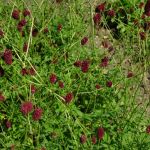| Common Name: |
Greater Burnet |
| Botanical Name: |
Sanguisorba officinalis syn. Posterium officinalis |
| Genus: |
Sanguisorba |
| Family: |
Rosaceae |
| Native Location: |
Europe to China and Japan; Naturalized in parts of N America. |
| Cultivation: |
Moist, well-drained soil in sun or partial shade. |
| Propagation: |
Propagate by seed sown in autumn or spring; by division in autumn or spring. |
| Harvest: |
Leafy parts are cut before flowers open and dried for use in infusions, liquid extracts, and tinctures. Roots are lifted in autumn and dried for decoctions. |
| Height: |
30cm-1.1m (1-3½ft) |
| Width: |
23-60cm (9-24in) |
| Hardiness: |
Z4-8 |
| Parts Used: |
Leaves, roots (di yu) |
| Properties: |
A bitter, astringent, cooling herb that controls bleeding, reduces inflammation, promotes healing, and destroys many pathogenic organisms. |
| Medicinal Uses: |
Internally for diarrhea, dysentery, ulcerative colitis, hemorrhoids, hemorrhage, and abnormal uterine bleeding. Externally for burns, scalds, sores, and skin diseases. An ingredient in Chinese formulas to treat cervical erosion and uterine and gastrointestinal hemorrhages, and in a dentrifice for peridontal disease. Roots are often stir-baked or charred to increase astringency. |
| Culinary Uses: |
Young leaves, leaflets, and unopened flower heads are added to salads, stir-fries, and soups. Dried leaves are made into tea. |
| Bibliography: |
The Encyclopedia of Herbs by Deni Bown Copyright © 1995,2001 Dorling Kindersley Limited pg. 358 |

